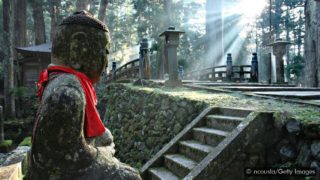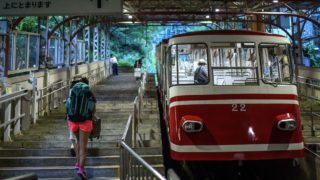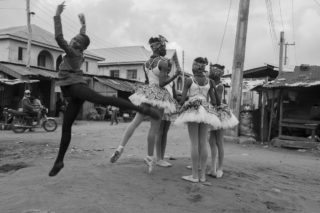A walk in the woods
In 816 AD, a monk named Kukai wandered into the thickly forested slopes of Mount Koya (Koya-san) in Japan’s Wakayama Prefecture in hope of finding a suitable site to build a base for his newly founded Shingon sect of Esoteric Buddhism. He chose an 800m-deep valley surrounded by eight peaks, whose ridges resemble the petals of an eight-petaled lotus blossom. Twelve centuries and 117 temples later, Kukai’s spiritual wooded wonderland is a Unesco World Heritage site and one of Japan’s most sacred destinations – a place where the wafting aroma of incense, the chanting of shaved-head monks and the primeval air of forested cemeteries creates a spiritual experience like none other. (Credit: ncousla/Getty Images)
Worshipping the natural world
Today, Koya-san is part of the sacred pilgrimage routes known as the Kumano Kodo, whose towering cedar and cypress forests, crashing waterfalls and temple-studded peaks appear to be suspended among the clouds in certain places. This 307km network of moss-covered stones and earthen trails, which connect the three great Kumano shrines to Koya-san, attracts roughly 15 million visitors a year and reflects the ancient Japanese belief of worshipping nature. In the Japanese religion of Shintoism, forests and rocks can be inhabited by the spirits of gods (kami) and every element of nature is considered divine.
Of the 117 temples scattered throughout Koya-san, some 50 of which serve as shukubo inns where guests can spend the night, meditate and commune with monks. And more than 1,200 years after Kukai (posthumously known as Kobo Daishi) first ventured into Koya-san’s secluded slopes, his spirit is believed to reside here in eternal meditation. (Credit: Stuart Black/Alamy)
The flying sanko
The story of how Kukai came to Koya-san merges fact and fable. Before arriving, he spent two years studying Esoteric Buddhism in China, and legend has it that as he prepared to sail home to Japan in 806 AD, he threw a three-pronged ceremonial tool called a sanko into the air, saying, “I have inherited these teachings, so if there is a good place to spread them, please go first and show me.”
The sanko allegedly flew towards Koya-san, and 10 years later while Kukai was walking through the woods, he met a hunter and his dogs who showed him a sanko stuck in a pine tree. Today at Koya-san’s head temple, the 16th-Century Kongobuji, the hunter and his dogs are depicted on ema votive tablets, on which visitors write their prayers to the gods. (Credit: Crystite RF/Alamy)
A sanctuary grows
Before Kukai could begin construction of his temple complex, he had to gain permission from Japan’s Imperial Court. Emperor Saga obliged in 816 AD. From then on, Koya-san’s growth – which reached 1,000-plus small temples during the Edo era between 1603 and 1868, and eventually merged into the current number of 117 – was closely tied to support from the Imperial family and aristocrats, samurai lords and commoners, many of which were keen to be close to Kukai’s spirit by visiting his mausoleum and by being buried in Koya-san’s Okunoin cemetery after their own passing.
Today, if you look at some of the monuments in the newer part of the Okunoin cemetery, you can see how major corporations have also bought into Koya-san. There are memorials to workers at companies such as Nissan, Panasonic, Sharp and others where colleagues and clients can come to pay their respects – some leaving their business cards after a visit in special post boxes in the monuments. (Credit: Joao Maia/Alamy)
An interesting mix
While you can’t ignore the tour buses, souvenir shops and crowds that make Koya-san a touristy destination (2 million people visit annually, but only 60,000 non-Japanese) the site, particularly at Okunoin, still feels like a very spiritual step back in time.
Even though the majority of the town of Koya-san’s 3,000 residents have strong connections to the Shingon sect – whether they are monks, nuns or working in related industries like the stone masons who make gravestones – Koya-san also has many traits of a normal Japanese town away from its temples. There are convenience stores and noodle houses in the backstreets, and izakaya gastropubs for a few drinks and a meaty dinner. It’s an interesting balancing act of ancient and modern that Koya-san manages to pull off. (Credit: Duy Phuong Nguyen/Alamy)
Entering Koya-san
Although some pilgrims still walk the trails to Koya-san, most worshippers and tourists today arrive by coach, car or a rail trip that culminates with a five-minute cable car ride from the base of Koya-san 900m up the mountains to the town of the same name. Yet, in the past, pilgrims from all over Japan would have finished their journeys on the 21km Choishimichi trail before passing under the two-storey Daimon, a 25.8m-tall vermillion gateway built in 1705 that’s protected by muscular Kongorikishi deity statues on each side.
However, just as the slopes of Mount Fuji were once off limits to women, and the sacred ground of a sumo ring is still, women were not allowed to enter the town of Koya-san until 1872. Just to the left of the Daimon is the trail that female pilgrims would have taken to one of the seven Nyonin-do halls that once skirted Koya-san: places from where they could worship without setting foot in Koya-san proper. (Credit: Nano Calvo/Alamy)

Open for all
After the Daimon, the next stop for pilgrims on the old trail would have been the Danjo Garan, the core complex of a dozen-or-so buildings that Kukai and his followers first built in Koya-san. Today, it’s one of Koya-san’s main stops for worshipers and tourists, even though most buildings here are relatively modern reconstructions. Among the more interesting points here is the pine tree in the Danjo Garan’s courtyard where Kukai’s flying sanko is said to have landed.
However, arguably the most striking component here is the Konpon Daito, a 47m, two-tiered pagoda. Inside, worshippers who visit purify themselves by rubbing a musty, clove-heavy incense onto their hands and pray before a bronze statue of Dainichi Nyorai (the central object of devotion in Esoteric Buddhism). The statue is shielded by four guardian statues and 16 painted columns that together form a three-dimensional metaphysical map of the cosmos. However, as Takimoto-san (a nun at the Konpon Daito) explained, anyone can enter. “Shingon is an open religion, you don’t have to be religious to visit Koya-san – many visitors aren’t. Anyone can come and light a candle or burn incense,” she says. (Credit: coward_lion/Alamy)

The spiritual centrepiece
Several hundred meters from the Danjo Garan stands Kongobuji, the head temple of some 3,600 Shingon temples nationwide. By Koya-san’s standards, Kongobuji is a newcomer, having been built in 1593 by the then-ruler of Japan, Toyotomi Hideyoshi, in honour of his deceased mother. But while Hideyoshi loved his mum, he wasn’t fond of everyone in his family and ordered his nephew, Hidetsugu, to commit ritual suicide. He obligingly did, in a tatami mat room in Kongobuji, in front of sliding screen doors adorned with the image of a heron perched upon a snow-clad willow. The artwork is one of a collection of priceless screen paintings still here that serve to highlight the Toyotomi’s wealth and power.
Just as striking is the Banryutei, Japan’s largest rock garden, which uses 140 granite rocks on a raked sand base to suggest the shape of a male and female dragon emerging from cloud to protect the temple. (Credit: Prisma by Dukas Presseagentur GmbH/Alamy)

A special cemetery
At the opposite end of Koya-san towards the cable car station is Okunoin, a sprawling forested cemetery through which pilgrims follow a 2-km pathway to reach Koya-san’s most sacred point: Kukai’s mausoleum, where he is said to sit in eternal meditation.
While walking under Okunoin’s towering cedars, nearly 200,000 tombstones and Buddhist memorials – stupas covered in moss and small jizo statues wearing red bibs – provide a dash of vibrancy in the filtered light. One then reaches the Torodo, a hall in front of the mausoleum, where more than 10,000 lanterns donated by worshippers burn in perpetuity. (Credit: John Steele/Alamy)

Day and night
Visit Okunoin by day and you encounter small numbers of modern-day pilgrims dressed in white, head topped by a conical straw hat and staff in hand, as well as groups of robe-clad monks flitting to and from the mausoleum – outnumbered by the tourists snapping photos of them. By night, the experience is entirely different. With the crowds gone, a menacing gloom cups the lantern-lit pathways, where the eerie silence is occasionally broken by insect song or flying squirrels cascading through the trees. (Credit: Nano Calvo/Alamy)

Temple stays
One of the most unique experiences pilgrims and less pious visitors can have at Koya-san is staying at one of the 52 temples that operate shukubo lodgings. In the past, these would have been largely no-frills affairs, but guests at shukubo today enjoy amenities that are not too dissimilar to staying at a ryokan (Japanese inn), with tatami mat guestrooms and futon bedding.
One major difference, however, is that shukubo are run by monks and are set within temple grounds. Another difference is the food, which is served in guestrooms by the younger monks. Breakfasts and dinners feature ingredients like mountain vegetables, tofu and beans, and in the Shingon tradition, is vegetarian.
“Koya-san’s vegetarian cooking was established under strict Buddhist rules prohibiting the eating of meat, and it’s been this way ever since Kukai founded Koya-san,” said Sesshu Kondo, one of the monks at the Ekoin Temple. “It uses limited ingredients and simple refinements to bring out the delicate flavours and reflect the seasons.” (Credit: John Lander/Alamy)

Fire ceremonies
Guests at a shukubo don’t experience life exactly as a monk, but they can get a taste of it through optional meditation sessions, sacred Buddhist sutra writing, and at temples such as Ekoin, by joining monks for the early-morning prayer session and fire ceremony.
Here, in a small lowly-lit hall, during a 30-minute ritual, a seated monk burns prayer sticks as several others chant and drum; an unremitting beat while the flames spit and rise. The fire symbolises the wisdom of Buddha, while the wood sticks represent human desires – the root of suffering – which the Buddha can burn away as one prays.
“The consecrated fire has a powerful cleansing effect both spiritually and psychologically. We perform it to destroy negative energies, detrimental thoughts and desires, and to make secular requests and blessings,” said Kondo. “It can be a profound experience.” (Credit: Rodolfo Contreras/Alamy)










